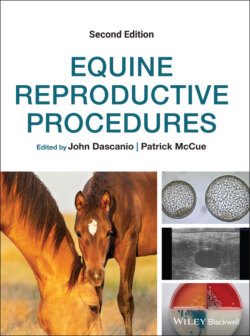Читать книгу Equine Reproductive Procedures - Группа авторов - Страница 99
Оглавление32 Hysteroscopic Hydrotubation of the Oviducts
Charles F. Scoggin
Rood and Riddle Equine Hospital, USA
Introduction
Hysteroscopic hydrotubation of the oviducts (uterine tubes) involves catheterizing the oviductal papillae (utero‐tubular junction) and flushing the oviducts in a retrograde fashion via endoscopic guidance. This technique is performed in confirmed or suspected cases of oviductal obstructions or in mares with unexplained infertility. Clinical studies in mares carrying their own pregnancy and embryo donors mares reported an ~80% success rate, in terms of either pregnancy or embryo recovery rates, within two cycles following the hydrotubation procedure.
In the author’s practice, this procedure is performed during diestrus or under the influence of progesterone when the cervix is tight to prevent air from escaping the uterine lumen during insufflation. It also requires a minimum of three experienced individuals: one person to pass the endoscope, another to drive the endoscope, and a third to operate the catheter and perform the flushing. The procedure is usually performed on each oviduct, after which the uterus is typically lavaged with lactated Ringer’s solution (LRS) and the mare administered a luteolytic dose of prostaglandin F2α. Treatment with antibiotics and anti‐inflammatory drugs may also be performed at the discretion of the clinician. Follow‐up therapy with daily lavages for 1–3 days post‐hydrotubation is recommended to reduce the risk of iatrogenic endometritis.
Equipment and Supplies
Sedation, previously sterilized 1 or 1.5 m flexible videoendoscope, 200 cm (79 inch) polyethylene tube with 1.7 mm OD (Hibiki high class grade size 5) with a 22 gauge 2.45 cm (1 inch) injection catheter attached to one end, 0.46 diameter and 220 cm (87 inch) long angiocatheter guidewire (Nit‐Vu® Angiodynamics®, Latham, New York, USA), 12 ml plastic syringes, 20 g × 4 cm (1.5 inch) needles, sterile obstetrical sleeves, examination gloves and sterile obstetrical lubricant, lactated Ringer’s solution, uterine lavage tubing, prostaglandin F2α.
Technique
The mare is placed in stocks and sedated appropriately.
The mare’s rectum is evacuated and her perineum prepared routinely for a clean vaginal procedure (see Chapter 3).
Using a sterile obstetrical sleeve and sterile lube, a 1 m flexible endoscope is advanced through the cervix and the uterus insulflated with air.
The scope is passed up to the tip of one horn and the papilla at the utero‐tubular junction is identified (Figure 32.1).
The catheter is fed through the injection port of the endoscope and, with the assistance of the guidewire, the orifice of the papilla is cannulated and the catheter is advanced over the wire and seated in place a few millimeters into the oviductal papilla (Figure 32.2).
The guidewire is withdrawn, and a 20 gauge 4 cm (1.5 inch) needle attached to a syringe with 10 ml of LRS is secured onto the opposite end of the catheter. Fluid is then pulsed through the tube and into the oviduct. Note: it is not uncommon to experience significant resistance when pulsing fluid through the oviduct. This can be counteracted by gentle rotation and slight withdrawal and advancement of the catheter system until fluid flows more freely. Movements should be relatively fine to avoid unseating the catheter.
The procedure is repeated on the contralateral oviductal papilla.
The uterus is lavaged with LRS (see Chapter 34) at the conclusion of the procedure and once daily for 2–3 subsequent days.
Prostaglandin F2α is administered intramuscularly to bring the mare back into estrus and allow her to clean out any contamination.
Figure 32.1 Hysteroscopic view of hydrotubation of the uterine tubes. The guidewire has been advanced a few millimeters from the distal tip of the catheter to facilitate cannulation of the orifice of the uterine tube papilla.
The oviduct is an important link between the ovary and uterus, and is the site of fertilization in vivo. Past research has shown that oviductal masses are not uncommon in mares, but the extent to which these masses can block or interfere with fertilization is unknown and likely only affects a small subset of mares. An accurate diagnosis of oviductal obstruction is difficult, and a presumptive diagnosis is often made by excluding other causes of subfertility. Consequently, diagnosis is often foregone and treatment is instead pursued to resolve potentially blocked oviducts.
Figure 32.2 Hysteroscopic view of the hydrotubation procedure with the catheter seated in the uterine tube papilla.
Further Reading
1 Bradecamp EA, Schnobrich MR. 2016. Hysteroscopic hydrotubation of the oviducts as a treatment for idiopathic infertility in the mare – a retrospective study. Proc Annu Conv Soc Theriogenol 8(3): 337.
2 Inoue Y. 2013. Hysteroscopic hydrotubation of the equine oviduct. Eq Vet J 45: 761–5.
3 Inoue Y, Sekiguchi M. 2017. Clinical application of hysteroscopic hydrotubation for unexplained infertility in the mare. Eq Vet J 50: 470–3.
